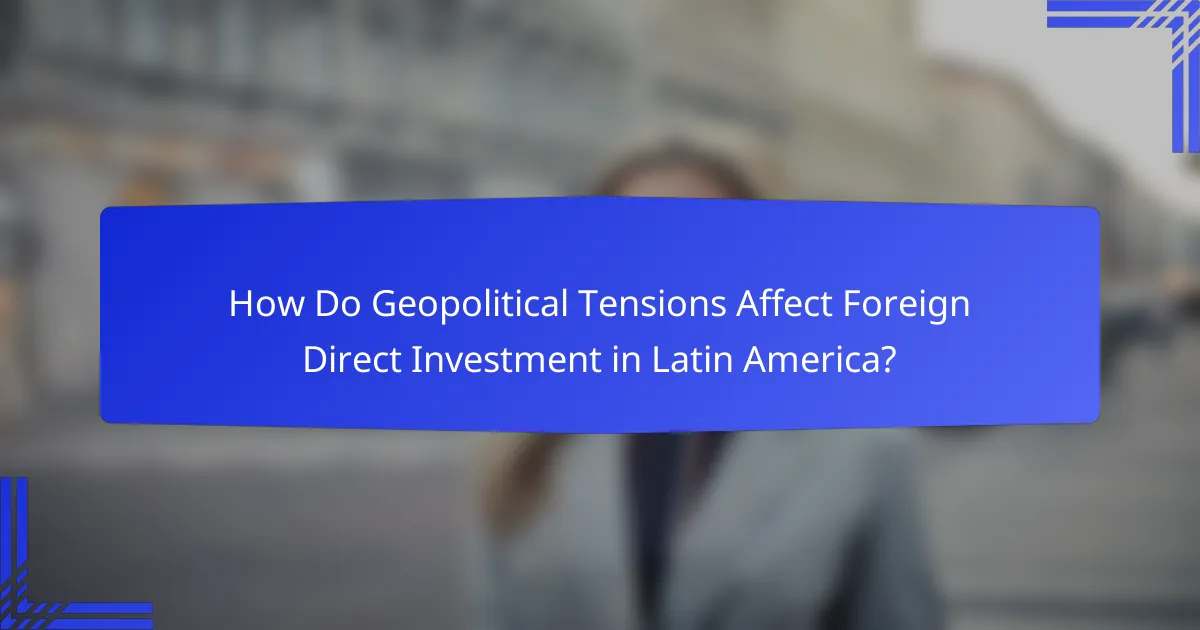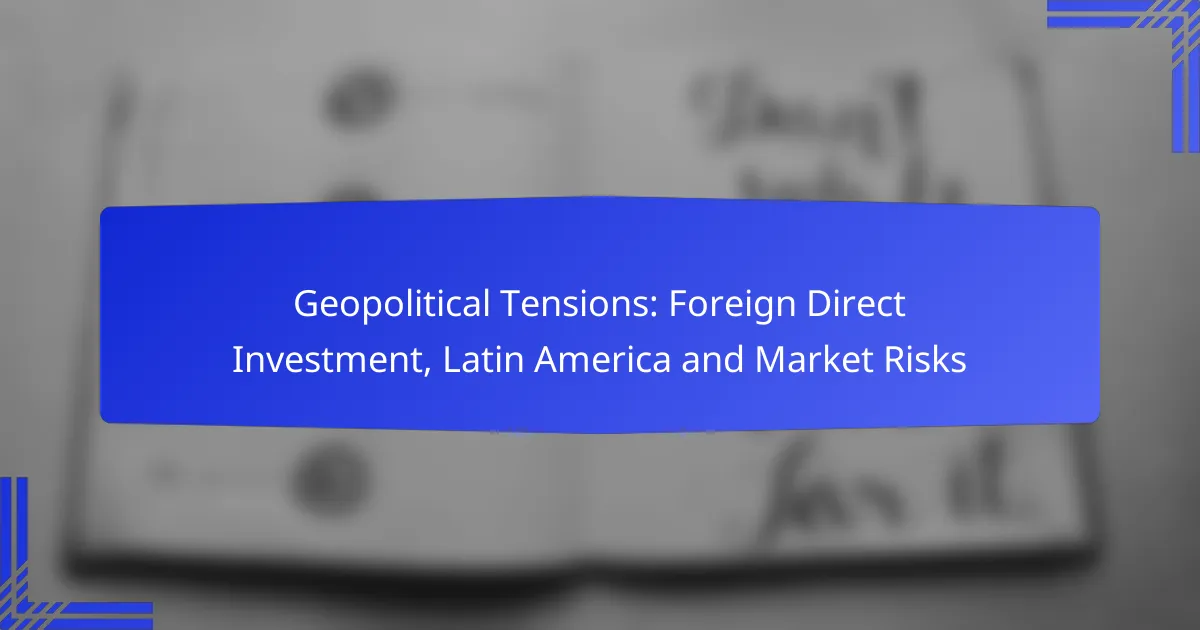Geopolitical tensions play a crucial role in shaping foreign direct investment (FDI) in Latin America, as they introduce uncertainties that can deter potential investors. These tensions contribute to heightened market risks, including political instability and economic fluctuations, which necessitate a thorough understanding for informed investment decisions. To navigate this complex landscape, investors can adopt strategies such as geopolitical trends and local partnerships to enhance stability and adaptability in their portfolios.

How Do Geopolitical Tensions Affect Foreign Direct Investment in Latin America?
Geopolitical tensions can significantly impact foreign direct investment (FDI) in Latin America by creating uncertainties that deter investors. These tensions often lead to increased risks, affecting market stability and investor behavior.
Increased market volatility
Geopolitical tensions can lead to heightened market volatility, which directly influences FDI decisions. Investors may experience fluctuations in asset values, currency exchange rates, and commodity prices, making the investment landscape unpredictable.
For example, during periods of heightened tensions, stock markets in Latin America may see sharp declines, prompting foreign investors to reconsider or withdraw their investments. This volatility can result in a cautious approach to new projects or expansions.
Shifts in investor confidence
Investor confidence is crucial for FDI, and geopolitical tensions can erode this trust. When conflicts arise or diplomatic relations sour, investors may perceive higher risks associated with their investments in the region.
As a result, foreign investors might delay or scale back their commitments, opting to invest in more stable environments. This shift can lead to a decline in new projects, affecting economic growth and job creation in Latin America.
Changes in regulatory environments
Geopolitical tensions can prompt governments to alter their regulatory frameworks, impacting foreign direct investment. In response to external pressures, countries may implement new laws or modify existing regulations to protect national interests.
For instance, a government may impose stricter controls on foreign ownership or increase tariffs on imports, which can deter foreign investors. Understanding these regulatory changes is essential for investors to navigate the complexities of the Latin American market effectively.

What Are the Key Market Risks for Investors in Latin America?
Investors in Latin America face several key market risks, including political instability, economic fluctuations, and currency depreciation. Understanding these risks is crucial for making informed investment decisions in the region.
Political instability
Political instability in Latin America can significantly impact investor confidence and market conditions. Frequent changes in government, civil unrest, and policy shifts can create an unpredictable environment for foreign direct investment.
For example, countries like Venezuela and Nicaragua have experienced severe political turmoil, leading to drastic economic consequences. Investors should closely monitor political developments and consider diversifying their investments to mitigate risks associated with instability.
Economic fluctuations
Economic fluctuations in Latin America can lead to varying growth rates and investment returns. Factors such as commodity price volatility, inflation, and changes in fiscal policy can cause significant shifts in economic performance across the region.
Investors should be aware that countries reliant on exports, like Brazil and Chile, may face challenges during global downturns. Conducting thorough market analysis and staying informed about economic indicators can help investors navigate these fluctuations effectively.
Currency depreciation
Currency depreciation poses a substantial risk for investors in Latin America, as it can erode returns and affect the value of investments. Many Latin American currencies are susceptible to external shocks, such as changes in U.S. interest rates or commodity prices.
For instance, the Argentine peso has experienced significant depreciation in recent years, impacting foreign investments. Investors should consider hedging strategies and monitor currency trends to protect their investments from potential losses due to depreciation.

How Can Investors Mitigate Risks in Latin America?
Investors can mitigate risks in Latin America by employing strategies that enhance stability and adaptability in their portfolios. Key approaches include diversification, engaging local partners, and utilizing risk assessment tools to navigate the complex market landscape.
Diversification strategies
Diversification is essential for reducing exposure to market volatility in Latin America. Investors should consider spreading their investments across various sectors, such as agriculture, technology, and energy, to minimize risk. For instance, allocating funds to both established markets like Brazil and emerging ones like Colombia can balance potential returns.
Additionally, geographic diversification can help. Investing in multiple countries within the region can protect against localized economic downturns. A mix of investments in both urban and rural areas can also provide a buffer against regional instability.
Engaging local partners
Collaborating with local partners can significantly enhance an investor’s understanding of the market dynamics in Latin America. Local firms often possess valuable insights into consumer behavior, regulatory environments, and cultural nuances that can affect business operations. Establishing joint ventures or partnerships can facilitate smoother market entry and reduce operational risks.
Moreover, local partners can assist in navigating bureaucratic hurdles and compliance with local regulations, which can vary widely across countries. This collaboration can lead to more informed decision-making and improved adaptability to changing market conditions.
Utilizing risk assessment tools
Risk assessment tools are vital for identifying potential threats and opportunities in Latin American markets. Investors should leverage quantitative models and qualitative analyses to evaluate political stability, economic trends, and market conditions. Tools such as SWOT analysis (Strengths, Weaknesses, Opportunities, Threats) can help in understanding the competitive landscape.
Additionally, staying informed through reputable sources and market reports can enhance risk management strategies. Regularly updating risk assessments based on current events and economic indicators can help investors make timely adjustments to their portfolios.

What Role Do Trade Agreements Play in Foreign Direct Investment?
Trade agreements significantly influence foreign direct investment (FDI) by creating a more predictable and stable environment for investors. These agreements typically establish rules that facilitate investment flows, reduce costs, and enhance protections for foreign investors.
Facilitation of cross-border investments
Trade agreements simplify the process of cross-border investments by reducing bureaucratic hurdles and standardizing regulations. This makes it easier for companies to enter new markets, as they can navigate legal frameworks more efficiently. For instance, agreements like the United States-Mexico-Canada Agreement (USMCA) streamline procedures for American firms looking to invest in Mexico or Canada.
Moreover, these agreements often include provisions that encourage cooperation between countries, fostering a more favorable climate for investment. Investors can benefit from clearer guidelines on ownership structures and operational requirements, which can lead to increased confidence in making long-term commitments.
Reduction of tariffs
One of the primary benefits of trade agreements is the reduction or elimination of tariffs on goods and services. Lower tariffs decrease the overall cost of doing business, making it more attractive for foreign investors to enter a market. For example, the elimination of tariffs under the EU-Mercosur agreement could open up significant opportunities for European companies in South America.
Additionally, reduced tariffs can enhance competitiveness by allowing foreign firms to offer products at lower prices, which can lead to increased market share. Investors should assess how tariff reductions can improve their profit margins and overall business viability in the host country.
Enhanced legal protections
Trade agreements often include provisions that enhance legal protections for foreign investors, such as guarantees against expropriation and the right to fair and equitable treatment. These protections are crucial for mitigating risks associated with political instability or changes in government policies. For instance, the inclusion of investor-state dispute settlement (ISDS) mechanisms allows investors to seek redress through international arbitration if their rights are violated.
Understanding the legal protections offered by a trade agreement can help investors make informed decisions about where to allocate their resources. It is advisable to review the specific terms of these agreements to identify the level of protection available and any obligations that may arise from them.

How Do Economic Policies Impact Foreign Direct Investment?
Economic policies significantly influence foreign direct investment (FDI) by shaping the business environment and determining the attractiveness of a country for investors. Key factors include tax structures, regulatory frameworks, and overall economic stability, which can either encourage or deter foreign capital inflows.
Tax incentives for foreign investors
Tax incentives play a crucial role in attracting foreign investors by reducing their overall tax burden. Countries often offer reduced corporate tax rates, tax holidays, or exemptions on certain income types to make investment more appealing.
For instance, some Latin American nations provide tax incentives for specific sectors like renewable energy or technology, which can lead to significant savings for foreign companies. Investors should evaluate the duration and conditions of these incentives to maximize their benefits.
Regulatory reforms
Regulatory reforms can enhance the investment climate by simplifying processes and reducing bureaucratic hurdles. Streamlined procedures for business registration, licensing, and compliance can make it easier for foreign entities to enter the market.
Countries that have undertaken significant regulatory reforms, such as improving property rights and enhancing contract enforcement, often see increased FDI. Investors should stay informed about ongoing reforms and assess how these changes may impact their operations and profitability in the region.
